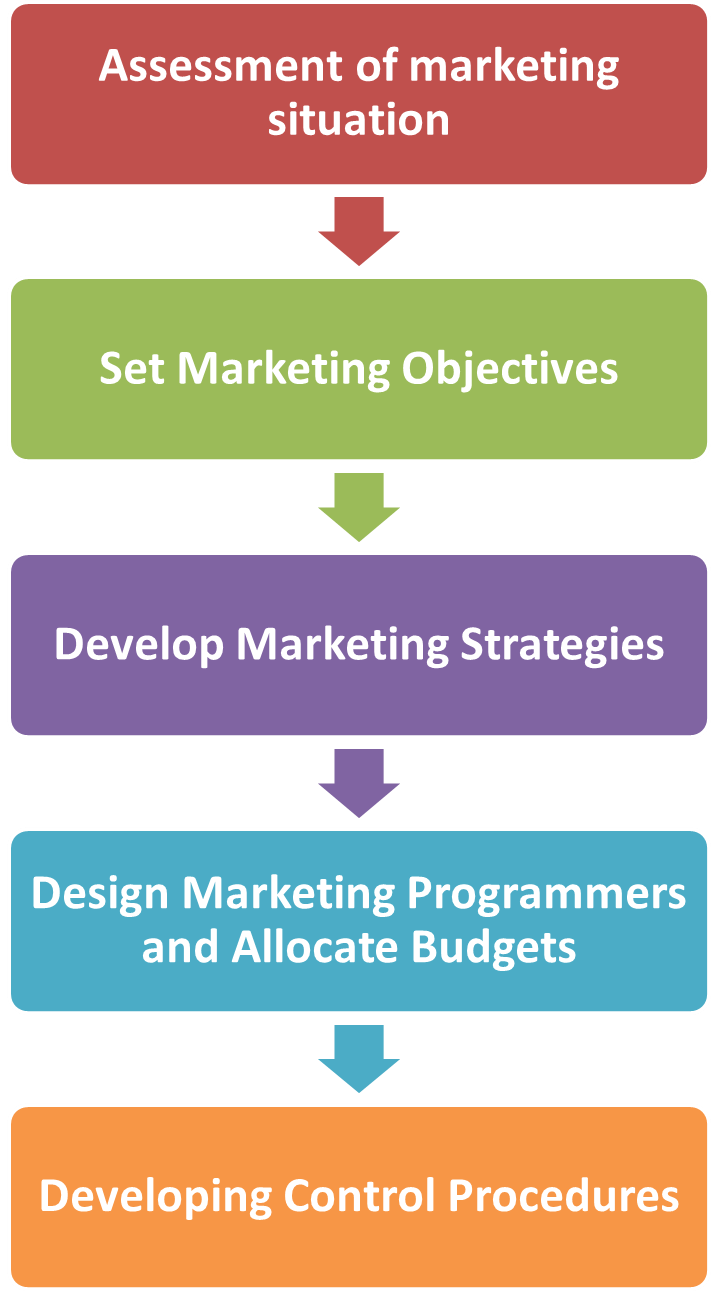A Marketing Plan is a written document outlining the marketer’s experience about the market. It also denotes the ways in which an organization plays to attain its marketing objectives.
Steps in Designing Marketing Plan

The marketing plan can be developed by adopting the following five steps,
Step 1: Assessment of marketing situation
The first step of the marketing planning process is the assessment of marketing situation. The main objective of this step is to understand the present situation of the product in the market. Situation analysis is the analysis of company’s present, future and past marketing programmer. On the basis of the results obtained by situation analysis, the management has to decide whether there is a need to revise the earlier plans or to establish new plans so that goals can be effectively achieved.
Step 2: Set Marketing Objectives
The second step in the marketing planning process is to set the reliable and measurable objectives. Marketing plan is designed on the basis of marketing objectives, which may be expressed in terms of profits, growth, market share and diversity. The set of marketing objectives must be attainable, understandable and brief.
Step 3: Develop Marketing Strategies
Marketing strategies are developed to achieve marketing objectives. In what way the marketing objectives could be achieved is specified by the marketing strategy. In this step, both the target markets and the marketing mix are required for satisfying the needs and expectations of the target market customers.
Step 4: Design Marketing Programmers and Allocate Budgets
This step involves designing marketing programmers and allocating the required budgets which are essential for performing the marketing tasks. This is a very important step as the annual budget is decided. Under this step based on the requirements, the stated budget may be approved, decreased or increased.
Step 5: Developing Control Procedures
The process of a marketing plan gets completed once it reaches the Control Step. The control procedure is the process by which the outcomes of the plan are assessed on a continuous basis. The sales performance of the company is compared with the sales quotas and expectations. If a sales performance is found to be less than that of the sales quotas, corrective measures need to be taken to overcome this deviation.
Contents of Marketing Plan
The content of the marketing plan comprises the following elements,
(i) Executive Summary
The essential objectives and recommendations of the marketing plan are described briefly in a summary form in this section. This summary assists the company in management review and picking out the essential points without consuming much time.
(ii) Present Marketing Condition
The target market and company’s position in it are specified clearly in this section. Apart from this, information pertaining to market, product performance, distribution and competition prevailing in the market is also provided.
(iii) Opportunities and Threats Analysis
Identifying the opportunities and threats of external environment which may influence the company and its marketing strategies either positively or negatively.
(iv) Set Objectives and Discuss the Issues
Setting marketing objectives which a company wants to achieve during the planning period. State the issues which influence company’s objective attainment.
(v) Marketing Strategy
Marketing strategy comprises of marketing mix strategy, positioning strategy, target market strategy and marketing expenditure strategy. The marketing strategy states how a company will create customer value and how it will react to the opportunities, threats and issues specified in the above sections.
(vi) Action Plan
How marketing strategies are going to be implemented is discussed in this section.
(vii) Marketing Budget
States the marketing budget which consists of information pertaining to projected sales and projected costs of production, distribution and marketing activities.
(viii) Control
Proper control helps in keeping track on marketing performance, measuring return on marketing investment and taking up corrective measures.
